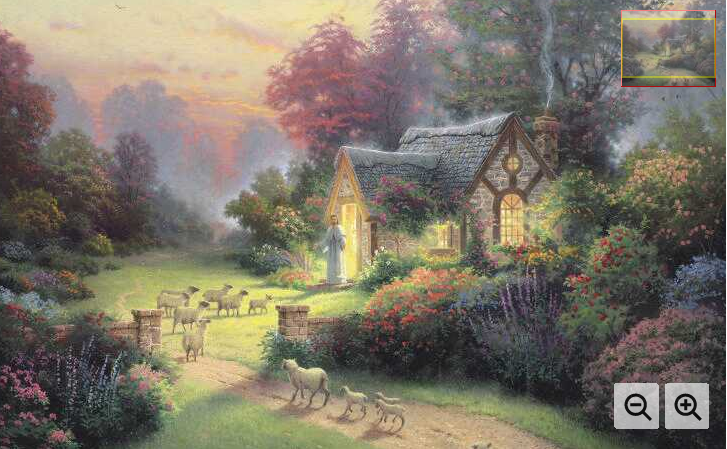Editor’s Note: Guest blogger Jeremy Hamilton-Arnold writes about the dangers of bad religious artwork. Jeremy lends his expertise as a Christian art historian and adds his voice as a Millennial to our continuing discussion on what attracts or repels young people about church.
By Jeremy Hamilton-Arnold

A pastor friend of mine asked me the other day if I knew of any good examples of art that depicted God as not an old white dude. Just going off the top of my head, I found it a surprisingly difficult task. While I may admit to knowing a thing or two about art history, my visual memory has been permanently imprinted with that aged white man that my friend wanted to avoid. Thankfully, there’s Google Images to help jog my aesthetic memory.
Yet I was distracted when Google gave me a depiction not of God, butof Jesus. My jaw dropped straight to the floor. I know there are some bad Christian art images out there, but this one takes the cake.
There’s Jesus—white, of course—holding a black baby in the child’s natural habitat: the Serengeti. Jesus presses his lips to the infant’s head as he looks out, perhaps eyeing a pack of rabid hyenas that could’ve eaten the poor thing if it weren’t for Jesus. The baby’s gaze meets our eyes. And we melt as we say, “Awww. Jesus sure does love the little children, don’t he? Even the black babies in Africa.”
…excuse me while I go throw up and rock myself in a corner.
Here’s where it gets worse: The paragraph to the side of this glorious example states, “The Savior holds a young African child, protecting him from the problems of a difficult world. This image was inspired by the artist’s time in Africa as she assisted in a great humanitarian effort to help the children of that troubled continent. This is a work filled with the Charity that the Savior asks all of us to have.”
There are clearly more problems here than the work just being kitsch (that is, being aesthetically saccharine, unoriginal, and sentimental, along with being easily reproducible and largely commercial). As a Christian who is passionate about including good art in our sacred spaces, I am irritated at another representation of a white Jesus that an artist asks us accept, buy, and hang on a wall to be admired. Clearly, the artist believes Jesus to be a white man because of her emphasis on contrasting skin tones and naturalistic style. Clearly, the artist thinks the people of Africa, or at least the babies of that continent, need to be saved–in both senses of the word. Clearly, the artist is ignorant of her white privilege that is expressed in her making Jesus white and “saving” an African infant “in situ.”

There are countless other examples out there of bad Christian art like this, which I firmly believe is another reason why Millennials are leaving the church. It’s not just because of outdated and judgmental theologies preached from pulpits, but also from the image-lined walls down the hall. It’s because of the adoration many Christians have for Thomas Kinkade, Warner Sallman, and Precious Moments, and other easily digestible gauzy artworks that feature idealistic figures doing “nice” things. No, Christians don’t need to change their love for paintings with Jesus as a steroid-pumped boxer (a la Stephen Sawyer) because the subject and aesthetic are tacky. Christians need to back away from these artworks because they promote bad theology.
Every work of Christian art has a message. The one in Swindle’s artwork above reinforces a white savior industrial complex. By placing a work like this up in your home, or worse, at your church, you are not merely decorating a blank wall. Whether you know it or not, you are putting up a billboard for a neo-colonialist brand of Christianity.
Forgive me for reducing all art to highway advertising, but I do so to make this point: all art has a message. Some works are straightforward; others are more mysterious. Some have a message that promotes privilege; others have a message that promotes social justice. Some artworks push at the boundaries of aesthetic assumptions and break molds. God doesn’t always have to be the white bearded “Father God.” Jesus doesn’t always have to be a sexy long-haired white dude. There can be other depictions, other guises. There can even be other subjects that are still relevant and spiritually moving in ways new and profound. And for subjects that are directly inspired from the Bible, there are more interesting ways to aesthetically re-envision them.

There certainly are artists out there doing so while (re)claiming the title ‘Christian artist.’ Take CIVA for example, which stands for Christians in the Visual Arts. Many of the artists involved are making art worth showing, sharing, and talking about.
Or take the folks creating the St. John’s Bible, a Bible made entirely through medieval methods of calligraphy and hand-painted illumination. They’re radically re-envisioning how scriptural narratives can be illustrated for today’s viewers in astounding ways
Yet you may argue, “What makes ‘good’ Christian art and ‘bad’ Christian art is wildly subjective–purely a matter of taste!” In a sense, such comments are warranted. People are entitled to like what they like!
But taste here goes beyond “I find the abstract expressionism of Pollock more profound than Warholian pop.” Christian art is different because it is representative of Christianity. When an artwork emanates harmful theological messages, that artwork is bad, and the effects of simply having bad taste can reverberate bad theology…loudly.
Christians must not simply reject bad art for good, however, but also explain why a work is bad, beyond just providing blanket statements like, “It’s tacky.” Further, Christians must also promote good Christian art with sound words for why it is good.
Who knows? One day, Googling “Christian Art” may actually yield results more compelling than cliché.


Jeremy Hamilton-Arnold has a Master of Arts in Art & Religion from the Graduate Theological Union in Berkeley, California. He is an instructor at First Street Gallery Art Center, an exhibition resource and arts management center for adults with developmental disabilities in Claremont, California.













